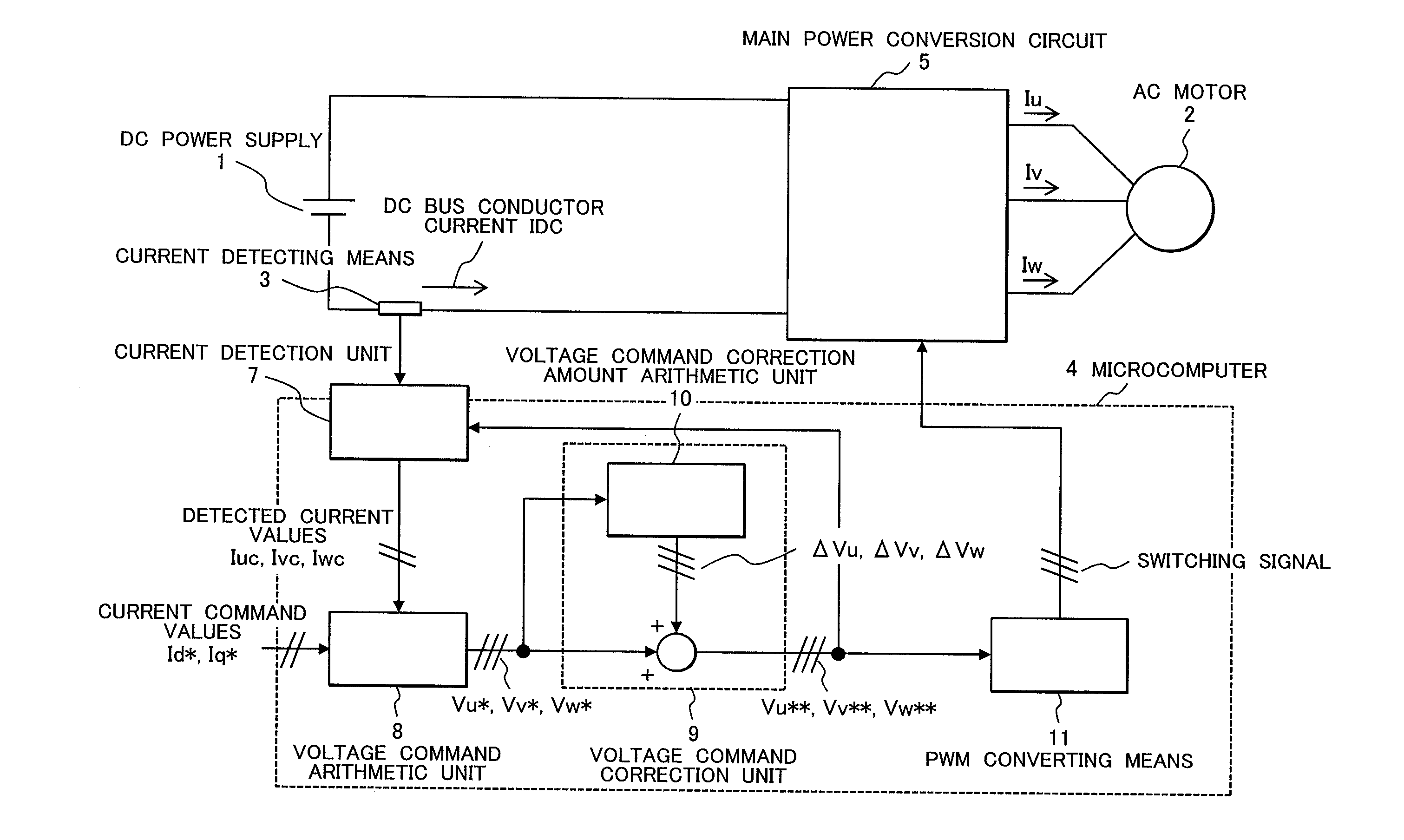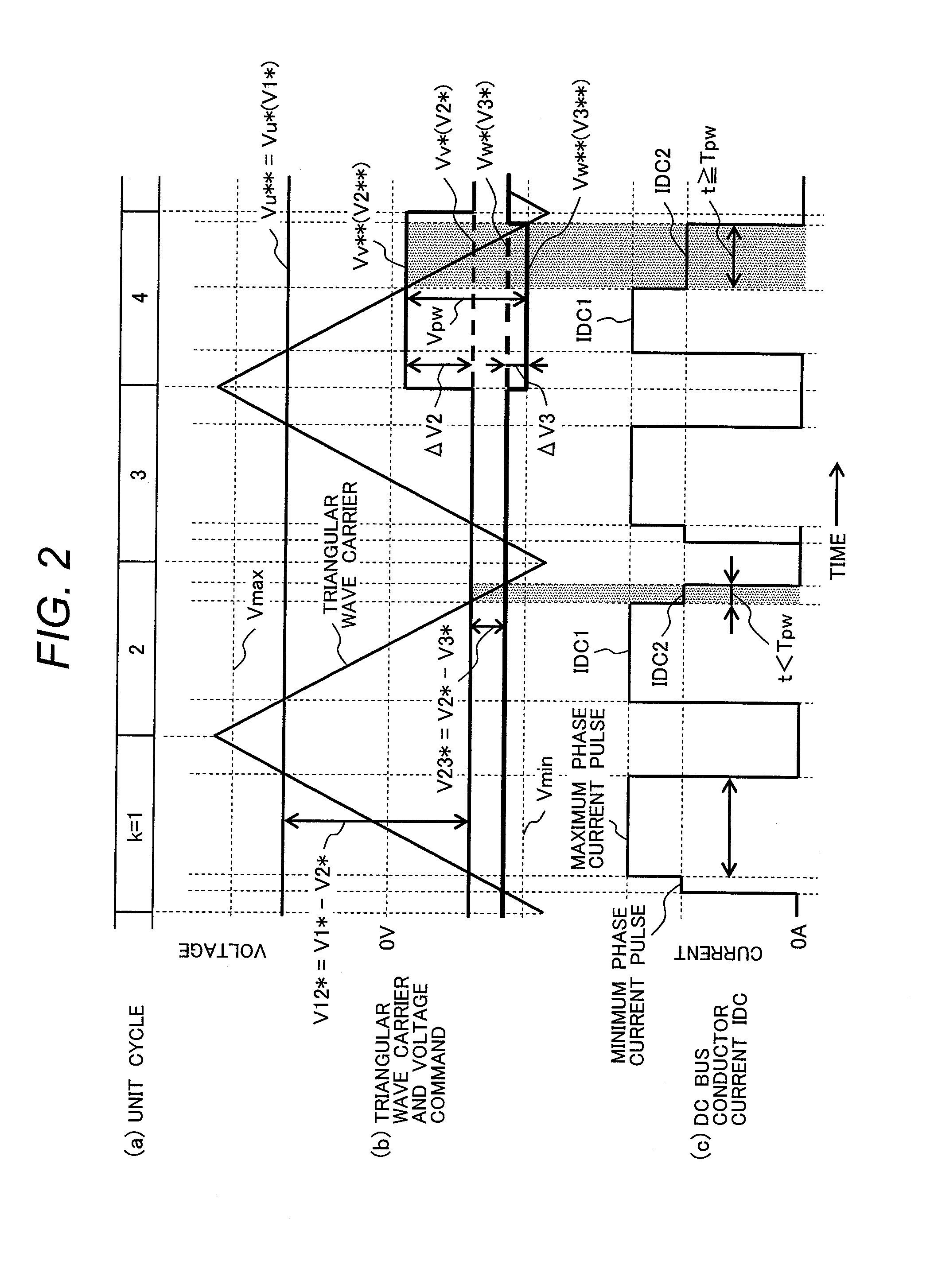Power conversion device and method for controlling thereof
a technology of power conversion device and power conversion method, which is applied in the direction of electric generator control, dynamo-electric converter control, dynamo-electric gear control, etc., can solve the problem of lowering the precision of motor control, and achieve stable, highly precise operation of motors.
- Summary
- Abstract
- Description
- Claims
- Application Information
AI Technical Summary
Benefits of technology
Problems solved by technology
Method used
Image
Examples
first embodiment
[0033]FIG. 1 is the entire structure of a power conversion device according to a first embodiment of the present invention. In FIG. 1, the interior of a microcomputer 4 indicates information flows and other portions indicate electric circuits (actual current flows).
[0034]In this embodiment, there are provided a DC power supply 1, a current detecting means 3 connected to a DC bus conductor, the microcomputer 4 that outputs a PWM signal on the basis of current information obtained from the current detecting means 3, a main power conversion circuit 5 that converts the electric power of the DC power supply 1 to AC electric power according to the PWM signal, and an AC motor 2 that works by using the converted electric power.
[0035]The microcomputer 4 has a current detecting part 7 that receives a DC bus conductor current IDC signal detected by the current detecting means 3, reproduces three-phase equilibrium currents Iuc, Ivc, and Iwc, and outputs these currents. The microcomputer 4 also ...
second embodiment
[0070]FIG. 4 illustrates a relation between the DC bus conductor current and three-phase voltages in a second embodiment of the present invention. Features of the second embodiment will be described with reference to this drawing. In this embodiment, the voltage command correction amount added in current detection as in the first embodiment is compensated in a period during which current detection is not carried out. Then, the second voltage command and first voltage command can be made the same, enabling a normal operation to be maintained. As for a compensation method, considering a period equal to N times the unit cycle as an adjustment period, as proposed in Patent Documents 2 and 3, correction amounts in a period during which current detection is not carried out may be set so that the average of correction amounts in all phases in the adjustment period is zero or substantially zero. In this embodiment, however, the intermediate phase is also corrected, so a problem arises in th...
fourth embodiment
[0083]FIG. 6 illustrates a relation between the DC bus conductor current and three-phase voltages in a fourth embodiment of the present invention. This embodiment is characterized in that the number N of unit cycles that determine the adjustment period is an odd number and a unit cycle in which detection is carried out is placed at the center of the adjustment period. FIG. 6 illustrates a case in which N is 3. The unit cycle for which k is 2 is the detection period, and the unit cycles for which k is 1 and 3 are the compensation cycles. The calculation of the voltage command correction amount in each detection period is carried out by using the method in the first embodiment, and the calculation of the correction amount in each compensation period is carried out by using the method in the second embodiment, so the following equations are set.
ΔV1[1]=ΔV1[3]=−ΔV10 / 2 (19)
ΔV1[1]=ΔV2[3]=−ΔV20 / 2 (20)
ΔV1[1]=ΔV3[3]=−ΔV30 / 2 (21)
[0084]If the voltage command exceeds Vmax or falls below
[00...
PUM
 Login to View More
Login to View More Abstract
Description
Claims
Application Information
 Login to View More
Login to View More - R&D
- Intellectual Property
- Life Sciences
- Materials
- Tech Scout
- Unparalleled Data Quality
- Higher Quality Content
- 60% Fewer Hallucinations
Browse by: Latest US Patents, China's latest patents, Technical Efficacy Thesaurus, Application Domain, Technology Topic, Popular Technical Reports.
© 2025 PatSnap. All rights reserved.Legal|Privacy policy|Modern Slavery Act Transparency Statement|Sitemap|About US| Contact US: help@patsnap.com



